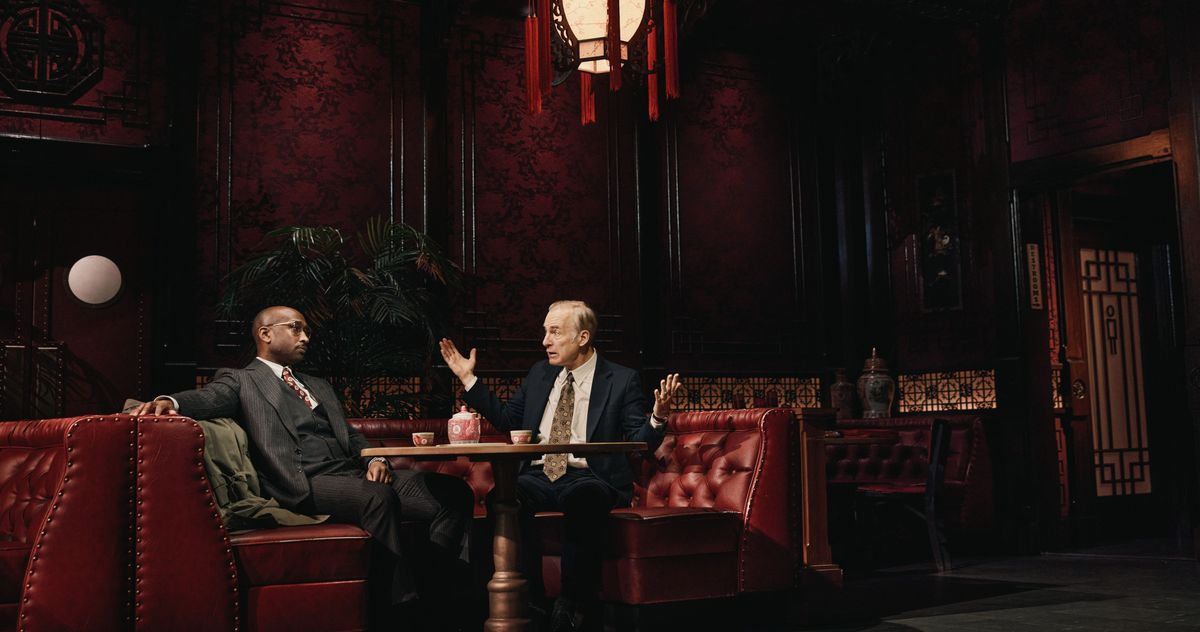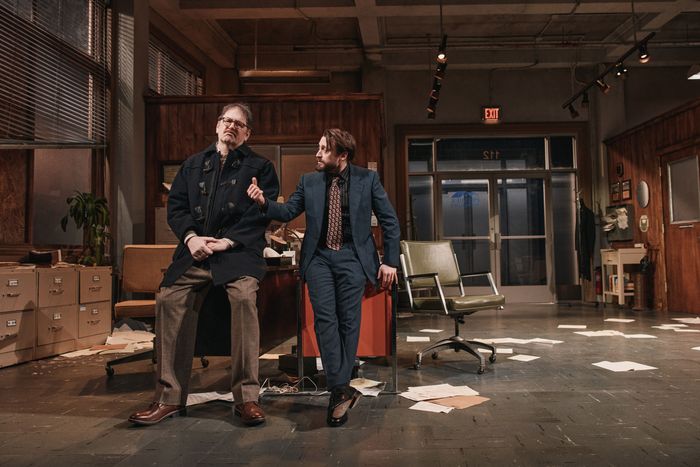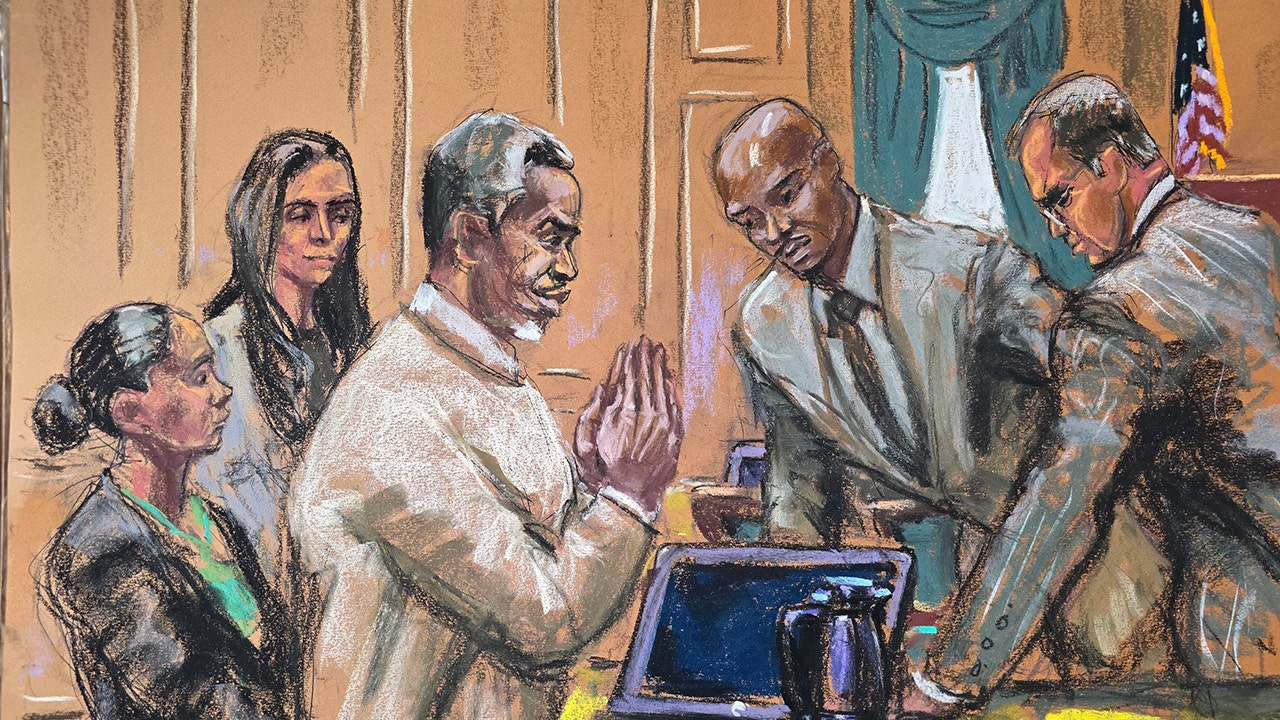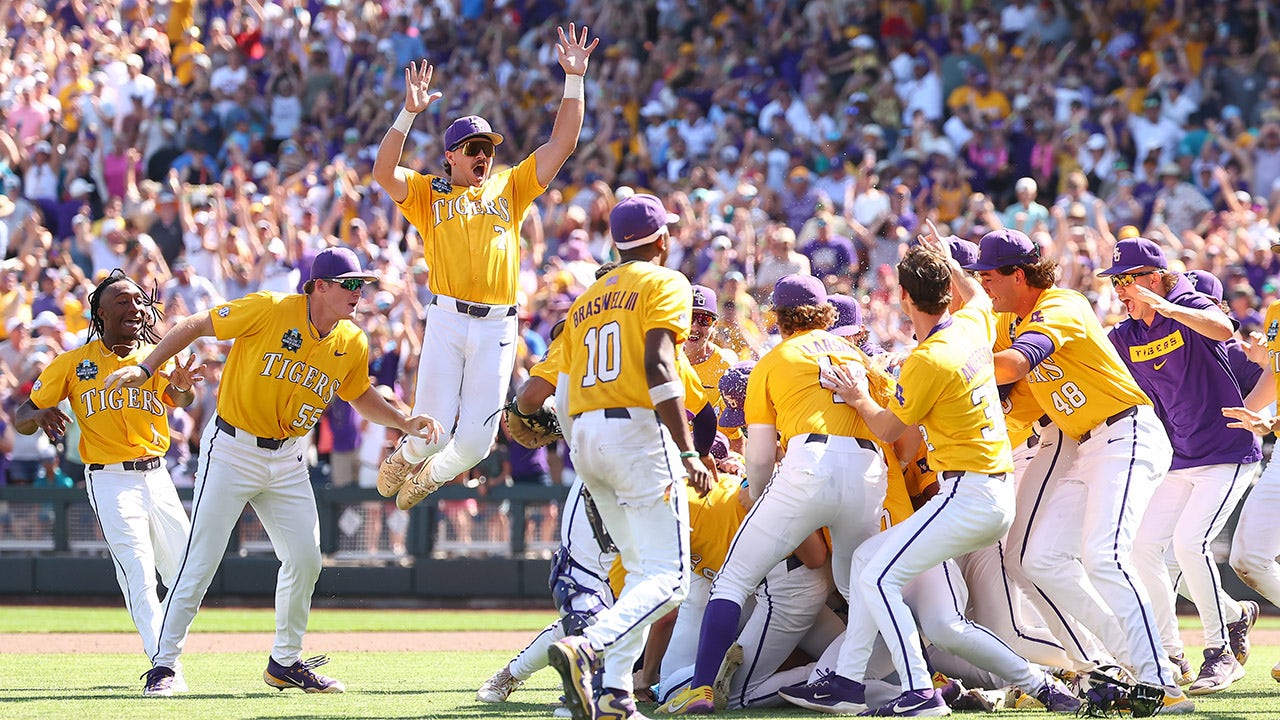Donald Webber Jr. and Bob Odenkirk in Glengarry Glen Ross.
Photo: Emilio Madrid
Watching David Mamet’s Glengarry Glen Ross, you could be forgiven for missing the three-word motto that’s become synonymous with the play. Though “Always be closing” is emblazoned across the new Broadway production’s merch, only one of Glengarry’s hungry-eyed salesmen utters the phrase, and almost in passing — as if musing on an ancient proverb while listening to an older, more seasoned warrior enumerate his battle scars around the evening campfire. The play premiered in 1983, but that “practical sales maxim,” which also served as its epigraph, didn’t rocket to icon status till nine years later, when Mamet built a new monologue around it for the film adaptation. (To paraphrase one YouTube commenter, Hyundai—a company whose car Alec Baldwin’s character definitely does not drive—might still be recovering from the withering vitriol.) Another 30-odd years down the road, we all know “ABC,” but how much do we really remember about Glengarry?
The starry revival currently at the Palace Theatre offers a refresher — though not necessarily deep feelings of purpose or clarity. It’s one thing to dust off your old copies of American Buffalo or Three Uses of the Knife; it’s another, at this point in time, to continue blithely putting money in David Mamet’s pockets, as either producer or ticket-buyer. Always proudly perverse, the writer has, over the past decade or so, strutted ever more belligerently to the right — the stereotypical conservative swing of the kind of guy whose previously avowed liberalism largely rested on his ability to say whatever he wanted about whomever he wanted, and to be consequently praised for his ballsiness. These days, Mamet thinks he’s been blacklisted by hypocritical totalitarian leftists, but he’s still got plays on Broadway, plays in the West End, and books coming out whenever he writes them. His next one is called The Disenlightenment: Politics, Horror, and Entertainment. At least the middle third of the subtitle is bound to be accurate.
We can all debate the separation of art and artist until the cows turn blue in the face, but the Mamet of today casts a particularly queasy pall over his own corpus: Looking back, it’s hard to see plays like Glengarry Glen Ross—a kind of Death of a Salesman for the Reagan generation—fully as satires. Instead of biting send-ups of the kind of awful men who shape themselves gleefully, wolfishly, into capitalism’s cogs, Mamet’s worlds now feel more like fascinated anthropological studies. At best they’re morally withholding; at worst they’re laced with cynical admiration. Everyone’s on the make, on the take, and a selfish prick or a manipulative bitch. There’s nothing to celebrate but winning and sounding badass while you do it. Coffee really is for closers.
Sounding badass—in that specific, high-octane, “fuck”-fueled, take-no-prisoners patter—is primarily what keeps drawing actors to Mamet, despite it all. College guys still drool over the idea of doing Richard Roma’s Act Three Glengarry monologue for scene-study class, the same way they do over putting up The Zoo Story year after year. The barbed banter is enough to have drawn Bob Odenkirk, Kieran Culkin, and Bill Burr onto the boards, though Patrick Marber’s production does little to distinguish or justify itself as a piece of live theater. Its presentation on the Palace’s wide stage is as neatly boxed in and meticulously decorated as any TV show’s set: In Act One, Scott Pask’s scenic design gives us every faux leather banquette and ornate hanging lantern of the kind of old Chinese restaurant where the menus were heavy green booklets and the drinks list started with a Mai Tai. Act Two moves us to a real-estate office you’d find in an ’80s strip mall — cheap wood paneling, sickly fluorescents, and no technology beyond the Touch-Tone phone. No sound designer is credited on the production, and between scenes, the lights by Jen Schriever simply cut to black before jumping back up again, revealing a new configuration of men poised to talk razors at each other. For some reason—presumably to cart all that realistic scenery around, or to allow the smaller-bladdered to pee—the show breaks up its brisk 105 minutes with an intermission, making it feel still less like an integrated event and more like a set of snapshots: those classroom scene studies, just with famous people instead of students.
Still, there was never any doubt that Mamet’s brand of spiky, sputtering American masculinity would, in different ways, fit Odenkirk, Culkin, and Burr. All three performers can weasel, bully, and talk a blue streak, and all are skilled at providing internal drive to text that can feel elliptical, coded, or without obvious dramatic action. (Glengarry’s characters rant and rail about “the leads,” “the board,” sits, percentages, and grosses the way online gamers go on about boosting, grinding, and pwning n00bs.) The play’s first three scenes introduce us to each actor’s salesman in ascending office pecking order: Odenkirk as the old hand Shelley Levene, past his heyday and fighting for his life; Burr as the demonic, disgruntled Dave Moss, who’s trying to strongarm the waffling oldtimer George Aaronow (Michael McKean) into a scheme to rob their office and sell the loot to a rival firm; and Culkin as the hot young cock of the walk, Richard Roma, safely at the top of the sales board and, when we first meet him, long-gaming a big, sad-eyed bear of a mark named James Lingk (the excellent John Pirruccello) with the kind of schmoozy, seductively rambling promises of self-actualization that would impress the most conniving men’s-rights activist.
Culkin’s interpretation might be the most distinctive, though only in terms of the character, not the actor’s own record of (impressively) playing versions of himself. Roma often goes to actors who run hot and lean in hard—Al Pacino played the role in the movie and was nominated for an Oscar—but Culkin, in his trademark manner, sits back. Especially in Act One, while ensnaring his prey with that sidewinding monologue, he shrugs rather than pushes. You can see Pirruccello’s basset-hound eyes light up, not because his Lingk is being browbeaten by an alpha but because Culkin’s Roma emanates that most tantalizing kind of charisma: the easy freedom of not giving a fuck.
Of course, he and everyone else have plenty of fucks to give overall (there are more than 150 in the script, about one and a half per minute). Especially once the office has been burglarized and the stakes have been raised in Act Two. There, the real depths of Roma’s nastiness are unleashed, along with the flop-sweaty extent of Levene’s desperation. Odenkirk has a gift for squirrelly, weirdly sympathetic bastards who can’t help playing cards they don’t have, and his Levene is fully convincing if not quite fully heartbreaking. For Glengarry to land its hardest, we’ve got to feel a measure of that Arthur Miller anguish in Levene’s ultimate downfall, no matter the character’s moral worth: Odenkirk shrinks toward pathos rather than expanding toward tragedy. Burr, meanwhile, plays Moss with a comedian’s ear for rhythm, setting up each blunt force blow and devious jab like so many cans to be shot off a fence. It works — there’s not much soul in Dave Moss to go digging for.
John Pirruccello and Kieran Culkin in Glengarry Glen Ross.
Photo: Emilio Madrid
As the play progresses, though, it’s the secondary cast, like Pirruccello’s shambling Lingk and McKean’s schlubby, nervy, none-too-sharp Aaronow that start to shine — along with Donald Webber Jr. as the icy young supervisor, John Williamson. Webber turns the unglamorous part into a slowburn stand-out: His Williamson takes the salesmen’s abuse with a spine like a two-by-four and a face like a woodcut until a chance to bite back presents itself. When it does, he seizes it without mercy.
The fact that Webber is Black and that Williamson’s expletive-slinging workforce is all white men adds a layer of friction to the production, but not one that it’s keen to investigate. A play like Glengarry doesn’t just register as a period piece these days because of the quaint scale of all its numbers ($5,000 for the “premium leads”! A top salesman’s $96,000 take for a hot year! Amazing, now, that these amounts are enough to kill and die over); it also shows its hoariness in the open racism and self-evident misogyny of its characters (key words open and evident). Here, there’s some cognitive dissonance around the salesmen’s seeming indifference to Williamson’s race versus their brazenness when it comes to everyone else, from “Polacks” to “Patels.” Is there a more vile line currently being said on Broadway than Moss’s about how all Indian women “look like they just got fucked with a dead cat”? (What does that even mean?) But people laugh at it, and that queasiness comes surging back: Is the vileness itself funny? Is that a good enough excuse? By spending time with these swaggering, slur-slinging men, what are we learning about ourselves that we haven’t already learned, aren’t already seeing enacted on the most brutal and demoralizing national scale, every single day? When recreation for some intersects so completely with real and present horrors for so many, when do our politics, our consciences, demand that we rethink how we allow ourselves to be entertained?
Glengarry Glen Ross is at the Palace Theatre.













